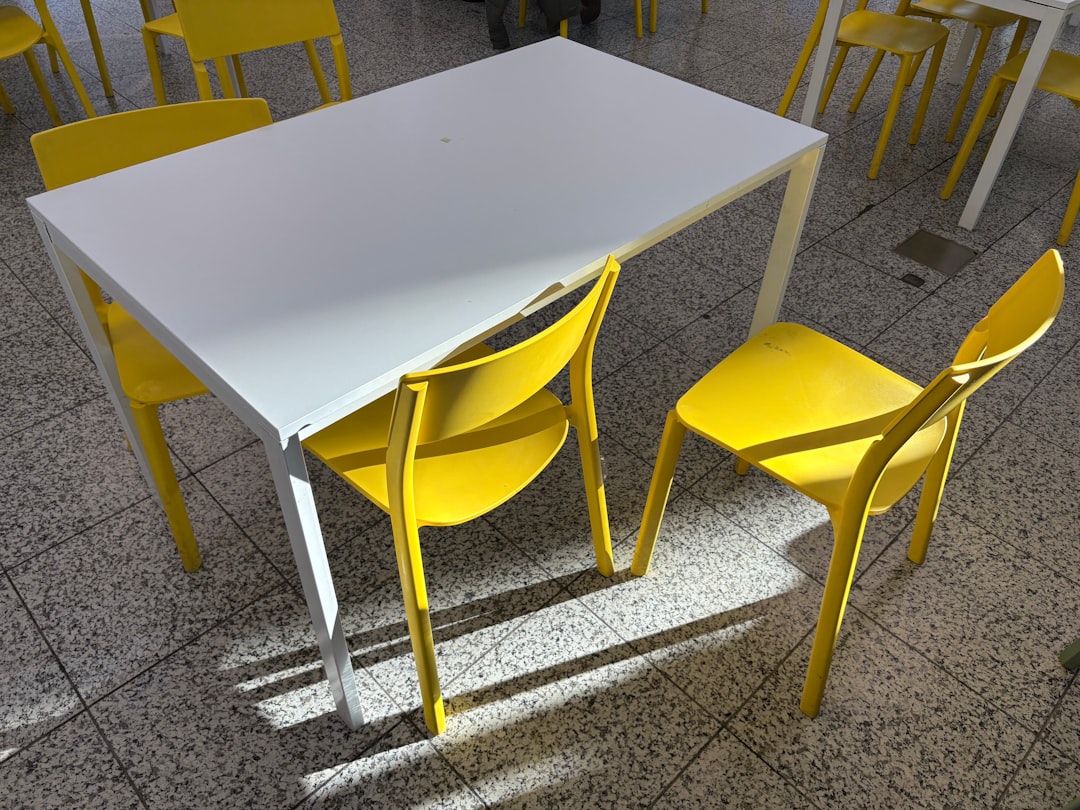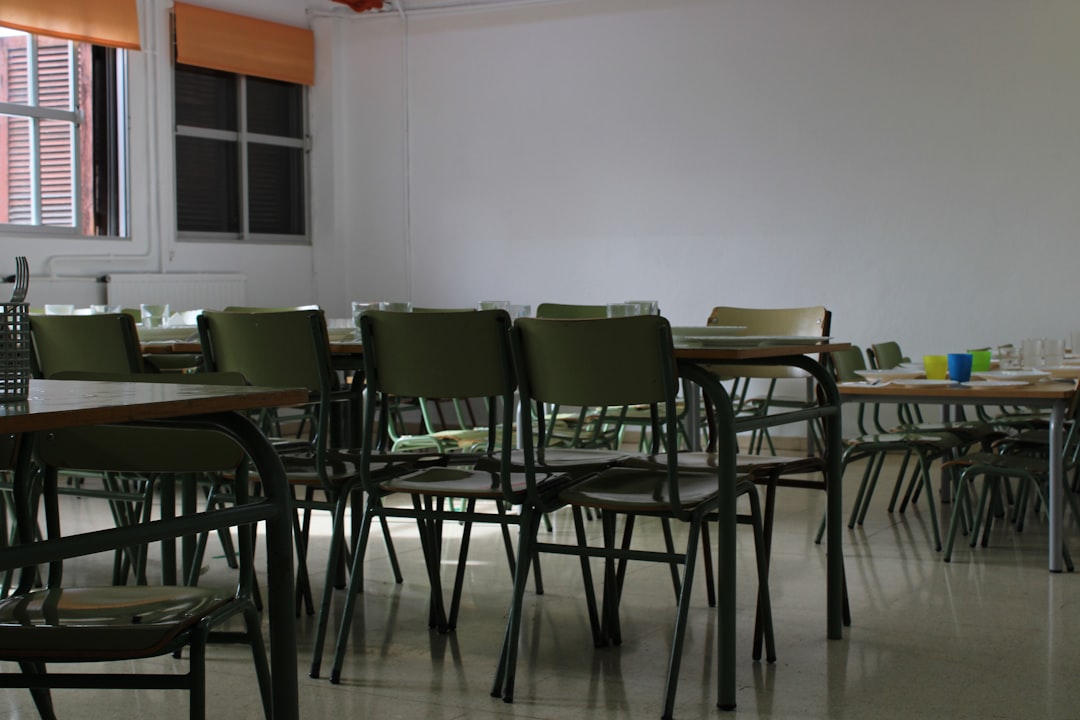

Engage prospects with a scan and streamline customer engagement with FREE QR code marketing tools by Sona – no strings attached!
Create a Free QR CodeFree consultation

No commitment

Engage prospects with a scan and streamline customer engagement with FREE QR code marketing tools by Sona – no strings attached!
Create a Free QR CodeFree consultation

No commitment
In today’s rapidly evolving education sector, school furniture suppliers face more than just the challenge of producing high-quality chairs or desks. A major pain point is capturing timely, actionable feedback from end users, such as administrators, teachers, and students, about comfort, ergonomics, and durability. When valuable input is lost in outdated feedback systems, suppliers miss out on insights that could inform product design and increase their competitive edge.
QR codes in education are bridging the gap between physical product experiences and digital feedback capture. For school furniture suppliers, these codes turn every item—desks, modular seating, or storage units—into a channel for immediate insights. Unlike paper or email surveys that typically have low response rates, QR code engagement happens in real time, allowing educators to quickly share their perspectives on classroom comfort and evolving furniture needs.
By embedding smart QR code processes into daily operations, suppliers can address problems such as untracked customer experiences and missed segmentation opportunities. QR codes not only speed up feedback collection but also improve data quality, allowing companies to detect trends, address emerging requirements, and optimize for regulatory standards while building stronger customer loyalty and a culture of continuous improvement.

A persistent frustration for many school furniture suppliers is the disconnect between product deployment and real-world user feedback. Manual forms often go unreturned or become outdated before anyone reads them. QR codes create a direct digital link at every product touchpoint, enabling instant feedback and increasing the chances that valuable responses are captured, attributed, and analyzed within your CRM. By reducing the friction to respond, you can reach a broader set of voices, including students, custodians, and installers, not just the primary purchasing contact.
To deploy QR codes strategically, design a feedback framework that maps to your customer journey and product lifecycle. Place codes where decision makers and users naturally interact with furniture. Then align every scan with a purpose, such as identifying ergonomic preferences by grade level, testing finish durability in high-traffic areas, or tracking maintenance requests. The more context you capture, the stronger your data becomes for informing product development and service improvements.
For example, replacing printed feedback cards in pilot classrooms with QR-enabled surveys can increase participation while also improving the quality of insights. A modern QR management platform like Sona QR can automatically sync responses to your CRM and tag responders by role and product, reducing manual work and preventing missed follow-ups. Over time, these scans build a living dataset that shows trends in satisfaction and performance at the level that matters most: by product, grade band, and district environment.

Slow feedback cycles and low survey participation can stall innovation and hurt customer satisfaction. Traditional methods often fail to capture input from anonymous users who interact with furniture daily, such as students or teachers rotating through shared spaces. Paper forms or buried email links rely on outdated workflows. By enabling feedback directly at the point of use, QR codes address these gaps and surface real classroom realities in a format that is quick to complete and easy to track.
Dynamic QR codes raise the value further because they let you modify destinations after printing. If you need to adjust your survey based on what you learn in the first week of a pilot, you can update the form without replacing labels. Integrated dashboards consolidate scans from multiple placements and show trends by time, campus, grade, or product line, which helps suppliers shift from reactive fixes to proactive improvements. This creates a continuous loop of learning that benefits design teams, account managers, and service operations at the same time.
In practice, QR codes belong on sample units, packing slips, installation checklists, delivery crates, and classroom labels. Each of these placements corresponds to a moment when someone has context to share, so you can gather practical insights without adding administrative burden.

School furniture suppliers serve diverse stakeholders, and contact lists are often fragmented or outdated. A flexible mix of QR code formats ensures that every touchpoint, from a demo room to a catalog mailer, leads to useful engagement. Selecting the right format for each scenario will determine how smoothly you collect feedback and how robust your data becomes for segmentation and follow-up.
When deciding on formats, consider who is scanning and what action they should take. Facilities teams may need Wi-Fi access to test devices in demo rooms, while teachers might prefer a one-tap email to report an issue. Procurement leaders may want to save your contact information instantly. Here are the most useful formats for this vertical:
Dynamic codes are recommended for any format tied to campaigns, surveys, or content that may change. Use static codes sparingly for evergreen assets such as a permanent PDF of safety guidelines or a general contact vCard.
Many growth opportunities are hidden in moments that do not show up in a CRM. During rollouts and pilots, teachers may improvise seating configurations or identify challenges with adjustability that never reach the sales team. QR codes placed at high-touch locations help surface these needs in real time, creating natural triggers for cross-sell, upsell, or service improvements across the furniture trade. Insights gathered during the first two weeks of a new classroom setup often shape satisfaction for the full school year, which makes timely collection critical.
Target scanning opportunities where a simple prompt can reveal a clear next step. For example, adding a QR code on a workstation monitor arm can collect data on height and reach preferences by grade level. That information can drive recommendations for ergonomic accessories. Likewise, a QR on storage solutions inside maker spaces can gather feedback on lock mechanisms and durability in high-traffic environments, informing both product decisions and lifecycle marketing with dynamic QR for furniture.
By treating offline interactions as the top of a digital funnel, suppliers can uncover real-time demand signals that would otherwise be invisible and take action before minor challenges become systemic frustrations.

The biggest obstacle to understanding which features resonate in classrooms is incomplete feedback that is not tied to specific products or users. QR codes address this challenge by capturing telemetry at the source. They empower you to collect feedback at the exact moment someone interacts with a chair, desk, storage unit, or lab bench, and to direct each scan to a workflow aligned with your goals.
These use cases apply across the customer lifecycle. Begin with pilot feedback and installation QA, then extend to ongoing service, maintenance, and expansion signals. The result is a unified feedback pipeline that informs account management and product roadmaps.
By operationalizing these use cases, you can ensure that even non-traditional touchpoints, such as maintenance closets or PT meetings, become opportunities to listen and respond.
Each scan is a signal that carries context. By deploying QR codes at multiple touchpoints, you can segment audiences automatically by role, intent, location, and lifecycle stage. This removes guesswork and enables precise, respectful follow-ups that match user needs, from teachers seeking ergonomic tips to procurement leaders evaluating district-wide rollouts.
Begin by mapping distinct QR codes to specific stages and roles. A sticker on a chair might tag the user as a teacher providing comfort feedback. A QR on the delivery slip would tag an installer submitting QA notes. These tags inform Sona playbook strategies for retargeting in your CRM and ad platforms so that future communications feel helpful rather than generic.
In education, clear audience distinctions are essential. Design your segments to reflect the realities of school operations, such as district-level purchasing, site-level maintenance, and classroom-level utilization. This context yields higher ROI on retargeting because you are acknowledging the different jobs to be done across the ecosystem.
QR codes connect offline product experiences to digital systems, transforming traditional assets into interactive engagement points. A connected mix ensures that wherever someone encounters your brand, from a brochure to a classroom label, there is a path to share feedback or take the next step. This also centralizes data from channels that used to be hard to measure, such as printed catalogs or installation manuals.
To maximize impact, align the QR destination with the medium and the moment. A scannable label in a busy classroom should lead to a short, mobile-friendly survey. A trade show QR can present a configurator or spec request form. An invoice QR should open a reorder or warranty page that is prefilled with the account and SKU.
QR codes serve as the offline onramp to your digital marketing engine. With a centralized platform like Sona QR, you can manage the entire fleet of codes, monitor performance, and sync scan data with your CRM and analytics tools. This builds a closed-loop system that ties classroom interactions to business outcomes.
The best QR campaigns start with clear goals, intentional design, and a testing plan. Use the following steps to launch and refine your program so that each scan becomes a reliable data point you can act on.
Clarify what you want to measure and why. For school furniture feedback, you might aim to measure ergonomic satisfaction across school types to catch issues before they grow, to validate a new laminate finish in high-traffic environments, or to assess installation clarity from third-party crews. Specific goals will shape your questions, QR placements, and the analytics you monitor.
Define how success will be evaluated. Decide on thresholds such as a minimum response rate per classroom, target comfort ratings by grade band, or a reduction in installation-related service tickets. Directing your campaign toward these outcomes makes every scan count.
Dynamic QR codes let you change destinations without reprinting labels. This flexibility is crucial when running pilots or multi-phase programs, since the most relevant questions can shift as you learn. Start with a brief satisfaction check, then transition the same code to collect six-month durability feedback or accessory requests.
Sona QR provides editable destinations and campaign controls so you can update targets in real time. This reduces waste and ensures that the feedback experience remains timely and aligned with your objectives. Start creating QR codes for free.
For classroom furniture, aim for visibility without adding distraction. Place labels where teachers and students naturally see them, such as the underside edge of a desk, the back of a chair, or a discreet corner of a storage unit. Use a concise, benefit-focused CTA, for example, Scan to rate comfort in 30 seconds or Scan to report a wobble for fast fix.
Test placement for scannability at different angles and in varying light. Verify that the code size, contrast, and print quality meet scanning standards. Include a short URL as a fallback for devices that cannot scan.
QR codes belong far beyond the product itself. Extend them to demo rooms, shipments, event signage, brochures, and installation instructions. When shipping pilot units, include a scannable card that welcomes feedback after one week and one month. At conferences, print QR codes on badges and posters that lead to feature ranking or sample requests.
Match placement to audience behavior and media context. A QR on a delivery slip is more likely to be scanned by installers, while a QR on a student desk label will capture end-user comfort data. Use Sona QR to generate unique codes for each placement so you can attribute scans accurately.
Once live, treat your QR program as an iterative process. Track scans by time, device, and location. Monitor conversion rates from scan to survey completion, and identify drop-off points that may signal confusing questions or poor mobile layout.
Use Sona QR analytics to compare performance across schools, products, and placements. A/B test CTAs, landing pages, and survey length. Sync data to your CRM so account teams can act on insights, such as reaching out to sites reporting lower comfort scores or promoting accessories that address the most common needs.
Collecting feedback is only the starting point. The real value comes from connecting scan activity to outcomes like retention, reorder rates, and product improvements. With modern QR tracking, you can go beyond basic scan counts and understand engagement at the classroom, product, and account levels. This allows you to prioritize fixes, scale popular features, and justify investments with clear data.
A robust analytics plan should capture both leading indicators, such as scan volume and survey completion rates, and lagging indicators, such as reduction in support tickets or increased accessory sales. Tagging each QR code by product SKU, school level, and placement gives you the granularity needed to pinpoint what works and where to improve.
Sona QR and Sona.com support these workflows with dashboards, identity resolution, and multi-touch attribution. You can link anonymous scans to known buyers, associate scan activity with web visits and email engagement, and build a complete journey from offline interaction to purchase readiness.
As you scale your program, small refinements can produce meaningful gains in response rates and data quality. Focus on clarity of purpose, ease of action, and consistent follow-up. Try to anticipate the needs of each role interacting with your products, then design QR experiences that match their expectations and time constraints.
You can also improve performance by aligning QR prompts with natural moments. For example, place a Scan now label on the installation checklist where the crew signs off on completion. In classrooms, include a Scan to rate week 1 comfort prompt timed to send a reminder email to teachers, which coordinates with lesson planning periods.
Creative deployments work well in education. Consider a QR label inside a custodian’s maintenance log for quick part reorders, or a QR on a student privacy panel that links to a brief check-in about noise levels and focus. These targeted prompts deliver practical insights you would never collect through a generic survey.

Delayed or incomplete feedback historically hindered early detection of product issues and slowed innovation. QR codes change the pace and precision of learning by capturing input at the point of use and by giving you an always-on channel to listen and respond. When executed thoughtfully, a QR-first feedback loop can improve both customer experience and operational efficiency.
Suppliers who integrate QR codes across pilots, shipments, and events typically see higher engagement and faster resolution times. They also uncover insights that influence design, such as the ideal range of desk height adjustability for middle schoolers or the most resilient edge banding for cafeterias.
Use these examples as inspiration to design campaigns that match your unique product mix and customer base. The most effective ideas are often simple and targeted to a specific moment in the classroom or installation process.
Lost opportunities often stem from QR codes that are hard to find, generic landing pages that do not respect the user’s time, or links that are never updated. The stakes are higher in schools, where attention is limited and daily schedules are tight. A small barrier can be enough to discourage scanning, meaning design and placement matter.
Focus on making every scan feel useful and effortless. The promise of a 30-second survey should be real. The landing page should recognize the product and the user role when possible. And your team should have a plan to use the data, so that participants see improvements or receive helpful resources in return.
Avoid common pitfalls such as using static codes for fast-changing campaigns, failing to tag scans by placement or product, or routing all scans to the same generic form. Thoughtful execution expands both the volume and the value of the insights you collect.
QR codes are now a crucial solution for school furniture suppliers seeking to transform daily product interactions into actionable feedback streams. By resolving challenges such as lost opportunities and outdated CRM data, QR-driven strategies help suppliers stay ahead of changes in ergonomic, sustainability, and regulatory demands.
Embedding QR code processes throughout the customer lifecycle, from demos to post-installation follow-up, ensures that no valuable feedback signal goes unnoticed. Combining smart segmentation and automated workflows with real-time analytics enables faster response to needs, better targeting, and improved product quality and retention.
With a data-powered, insight-driven approach, school furniture suppliers can turn classroom moments into measurable business value, driving product innovation and building stronger relationships in a competitive marketplace.
QR codes have transformed the school furniture suppliers industry from static feedback collection into a dynamic, measurable engagement tool. Whether it’s gathering real-time customer insights, enhancing post-purchase experiences, or streamlining product development feedback, QR codes replace outdated surveys with instant, mobile-friendly interactions that capture valuable data to optimize your offerings and customer satisfaction.
Imagine knowing exactly which furniture designs or features resonate most with schools—and being able to act on that feedback immediately to refine your products and boost client loyalty. With Sona QR, you can create dynamic, trackable QR codes in seconds, update feedback campaigns without reprinting materials, and connect every scan directly to actionable insights. No wasted effort, no missed opportunities—just smarter, more responsive customer engagement.
Start for free with Sona QR today and turn every scan into meaningful feedback, stronger relationships, and increased sales.
School furniture suppliers struggle to capture timely and actionable feedback from administrators, teachers, and students about comfort, ergonomics, and durability due to outdated feedback systems.
QR codes enable immediate, real-time feedback at the point of use, increasing response rates and data quality by linking physical furniture to digital surveys and service requests.
Suppliers should set measurable goals such as ergonomic comfort, durability, ease of assembly, or adjustability tailored to user types to ensure focused and actionable survey responses.
QR codes should be affixed visibly on sample products, seating, or storage units in locations where users naturally interact, such as desk edges, chair backs, or storage corners.
Dynamic QR codes allow suppliers to update survey destinations or content after printing, enabling multi-phase feedback collection without reprinting labels and reducing waste.
By tagging scans by role, such as teachers, installers, or custodians, suppliers can tailor follow-ups and gather relevant insights specific to each group's interaction with the furniture.
Useful QR code formats include web links to surveys, vCards for contact sharing, email or SMS triggers for service requests, Wi-Fi access for demo rooms, and links to app downloads or documents.
QR codes placed discreetly on furniture enable custodians or users to report issues like wobbly legs or damaged surfaces quickly, facilitating faster service response and preventative maintenance.
Creating unique QR codes for different customer journey stages, tagging scans by user role and location, and syncing data to CRM and ad platforms enable precise segmentation and targeted retargeting.
Suppliers should add QR codes to brochures, catalogs, event signage, installation manuals, and invoices to create interactive touchpoints that connect offline experiences to digital engagement and feedback.
Recommended steps include establishing clear feedback objectives, using dynamic QR codes, placing codes visibly with clear calls to action, distributing codes strategically, and monitoring analytics for refinement.
By collecting real-time feedback via QR codes on product wear, adjustability, and hardware quality, suppliers can detect issues early and make informed improvements to durability and safety.
While not explicitly detailed, modular furniture allows flexible seating and configurations that adapt to different learning activities and user preferences, which can be optimized through QR feedback.
Technology integration includes embedding QR codes on furniture for feedback, providing Wi-Fi access in demo rooms, linking to AR tools for layout visualization, and enabling digital service requests.
Feedback on material durability and wear collected through QR codes helps suppliers choose sustainable and resilient finishes suited for high-traffic school environments.
Using QR code feedback to monitor satisfaction and maintenance needs helps suppliers prioritize investments, reduce warranty claims, and optimize SKU mixes, supporting better budget allocation.
Trends include preferences for ergonomic adjustability, tool-less height adjustments, durable finishes, and inclusive designs informed by real-time classroom feedback collected via QR codes.
QR codes create a continuous feedback loop that enables faster issue resolution, tailored product improvements, and personalized communication, building stronger customer relationships.
Avoid placing QR codes in hard-to-see locations, using generic landing pages, failing to update content, not tagging scans properly, and neglecting to act on collected data.
Suppliers can track scan volume, survey completion, customer satisfaction trends, reorder rates, and service ticket reductions by integrating QR data with CRM and analytics platforms.
Use Sona QR's trackable codes to improve customer acquisition and engagement today.
Create Your FREE Trackable QR Code in SecondsJoin results-focused teams combining Sona Platform automation with advanced Google Ads strategies to scale lead generation

Connect your existing CRM

Free Account Enrichment

No setup fees
No commitment required

Free consultation

Get a custom Google Ads roadmap for your business






Launch campaigns that generate qualified leads in 30 days or less.
